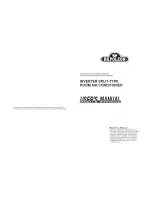
8
6. Electrical work
Function table
Select unit number 00
Mode
Power failure automatic recovery
Indoor temperature detecting
LOSSNAY connectivity
Power voltage
Auto mode (only for PUHZ)
Settings
Not available
Available
Indoor unit operating average
Set by indoor unit’s remote controller
Remote controller’s internal sensor
Not Supported
Supported (indoor unit is not equipped with outdoor-air intake)
Supported (indoor unit is equipped with outdoor-air intake)
240 V
220 V, 230 V
Energy saving cycle automatically enabled
Energy saving cycle automatically disabled
Mode no.
Setting no. Initial setting
Setting
01
1
2
1
02
2
3
1
03
2
3
04
1
2
05
1
2
Mode
Filter sign
Fan speed
No. of air outlets
Installed options (high-performance filter)
Up/down vane setting
Energy saving air flow
(Heating mode)
Settings
100 Hr
2500 Hr
No filter sign indicator
Standard (PLH/PLA)/Silent (PCH/PCA)
High ceiling
1
(PLH/PLA)/Standard (PCH/PCA)
High ceiling
2
(PLH/PLA)/High ceiling (PCH/PCA)
4 directions
3 directions
2 directions
Not supported
Supported
No vanes
Equipped with vanes (vanes angle setup
1
)
Equipped with vanes (vanes angle setup
2
)
Disabled
Enabled
Mode no.
Setting no. Initial setting
Setting
1
07
2
3
1
08
2
3
1
—
09
2
—
3
—
10
1
2
11
1
2
3
12
1
2
Select unit numbers 01 to 03 or all units (AL [wired remote controller]/07 [wireless remote controller])
7. Test run
7.1. Before test run
s
After completing installation and the wiring and piping of the indoor and outdoor
units, check for refrigerant leakage, looseness in the power supply or control
wiring, wrong polarity, and no disconnection of one phase in the supply.
s
Use a 500-volt megohmmeter to check that the resistance between the power
supply terminals and ground is at least 1.0 M
Ω
Ω
Ω
Ω
Ω
.
s
Do not carry out this test on the control wiring (low voltage circuit) termi-
nals.
Warning:
Do not use the air conditioner if the insulation resistance is less than 1.0 M
Ω
Ω
Ω
Ω
Ω
.
Insulation resistance
7.2. Test run
The following 3 methods are available.
7.2.1. Using wired remote controller (Fig. 7-1)
1
Turn on the power at least 12 hours before the test run.
2
Press the [TEST] button twice.
➡
“TEST RUN” liquid crystal display
3
Press the [Mode selection] button.
➡
Make sure that wind is blown out.
4
Press the [Mode selection] button and switch to the cooling (or heating) mode.
➡
Make sure that cold (or warm) wind is blown out.
5
Press the [Fan speed] button.
➡
Make sure that the wind speed is switched.
6
Switch the wind direction by pressing the [Airflow] or [Louver] button.
➡
Make sure that horizontal outlet, downward outlet, and other wind direction
adjustments are possible.
➡
Check operation of the outdoor unit fan.
7
Release test run by pressing the [ON/OFF] button.
➡
Stop
8
After the checks, always turn off the power.
7.2.2. Using SW4 in outdoor unit
Refer to the outdoor unit installation manual.
7.3. Self-check
7.3.1. Wired remote controller (Fig. 7-2)
1
Turn on the power.
2
Press the [CHECK] button twice.
3
Set refrigerant address with [TEMP] button if system control is used.
4
Press the [ON/OFF] button to stop the self-check.
A
CHECK button
B
Refrigerant address
C
TEMP. button
D
IC:
Indoor unit
OC: Outdoor unit
E
Check code
F
Unit address
ON/OFF
CENTRALLY CONTROLLED
ERROR CODE
CLOCK
ON
OFF
˚C
CHECK
CHECK MODE
FILTER
TEST RUN
FUNCTION
˚C
1Hr.
NOT AVAILABLE
STAND BY
DEFROST
FILTER
CHECK TEST
TEMP.
TIMER SET
D
E
F
H
IJKL M
G
C
B
A
Fig. 7-2
Fig. 7-1
ON/OFF
CHECK
FILTER
CHECK TEST
TEMP.
TIMER SET
B
C
A
STAND BY
DEFROST
INDOOR UNIT
ADDRESS NO
ERROR CODE
OA UNIT ADDRESS NO
CENTRALLY CONTROLLED
CLOCK
ON OFF
˚C
1Hr.
NOT AVAILABLE
˚C
CHECK MODE
FILTER
CHECK
FUNCTION
STAND BY
DEFROST
INDOOR UNIT
ADDRESS NO
ERROR CODE
OA UNIT ADDRESS NO
CENTRALLY CONTROLLED
CLOCK
ON OFF
˚C
1Hr.
NOT AVAILABLE
˚C
CHECK MODE
FILTER
CHECK
FUNCTION
a)
D
E
F









































